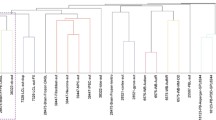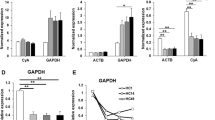Abstract
In order to provide an alternative approach for understanding the biology and genetics of autism, we performed statistical analysis of gene expression profiles of lymphoblastoid cell lines derived from children with autism and their families. The goal was to assess the feasibility of using this model in identifying autism-associated genes. Replicate microarray experiments demonstrated that expression data from the cell lines were consistent and highly reproducible. Further analyses identified differentially expressed genes between cell lines derived from children with autism and those derived from their normally developing siblings. These genes were then used to identify biochemical pathways potentially involved in autism. This study suggests that lymphoblastoid cell lines may be a viable tool for identifying genes associated with autism.



Similar content being viewed by others
References
American Psychiatric Association (1994). Diagnostic and statistical manual of mental disorders (4th ed.). Washington, DC.
Anderson, G. M., Freedman, D. X., Cohen, D. J., Volkmar, F. R., Hoder, E. L., McPhedran, P., Minderaa, R. B., Hansen, C. R., & Young, J. G. (1987). Whole blood serotonin in autistic and normal subjects. Journal of Child Psychology and Psychiatry, 28, 885–900.
Bailey, A., Le Couteur, A., Gottesman, I., Bolton, P., Simonoff, E., Yuzda, E., & Rutter, M. (1995). Autism as a strongly genetic disorder: Evidence from a British twin study. Psychological Medicine, 25, 63–77.
Bakay, M., Chen, Y. W., Borup, R., Zhao, P., Nagaraju, K., & Hoffman, E. P. (2002). Sources of variability and effect of experimental approach on expression profiling data interpretation. BMC Bioinformatics, 3, 4.
Buxbaum, J. D., Silverman, J. M., Smith, C. J., Kilifarski, M., Reichert, J., Hollander, E., Lawlor, B. A., Fitzgerald, M., Greenberg, D. A., & Davis, K. L. (2001). Evidence for a susceptibility gene for autism on chromosome 2 and for genetic heterogeneity. American Journal of Human Genetics, 68, 1514–1520.
Cheung, V. G., Conlin, L. K., Weber, T. M., Arcaro, M., Jen, K. Y., Morley, M., & Spielman, R. S. (2003). Natural variation in human gene expression assessed in lymphoblastoid cells. Nature Genetics, 33, 422–425.
Geschwind, D. H., & Gregg, J. P. (2002). Microarrays for the Neurosciences: An Essential Guide. Cambridge, MA: The MIT Press.
Geschwind, D. H., Sowinski, J., Lord, C., Iversen, P., Shestack, J., Jones, P., Ducat, L., & Spence, S. J. (2001). The autism genetic resource exchange: a resource for the study of autism and related neuropsychiatric conditions. American Journal of Human Genetics, 69, 463–466.
Gingrich, J. A., & Hen, R. (2001). Dissecting the role of the serotonin system in neuropsychiatric disorders using knockout mice. Psychopharmacology (Berl), 155, 1–10.
Gordon, C. T., State, R. C., Nelson, J. E., Hamburger, S. D., & Rapoport, J. L. (1993). A double-blind comparison of clomipramine, desipramine, and placebo in the treatment of autistic disorder. Archives of General Psychiatry, 50, 441–447.
Herrero, J., Al-Shahrour, F., Diaz-Uriarte, R., Mateos, A., Vaquerizas, J. M., Santoyo, J., & Dopazo, J. (2003). GEPAS: A web-based resource for microarray gene expression data analysis. Nucleic Acids Research, 31, 3461–3467.
Kakiuchi, C., Iwamoto, K., Ishiwata, M., Bundo, M., Kasahara, T., Kusumi, I., Tsujita, T., Okazaki, Y., Nanko, S., Kunugi, H., Sasaki, T., & Kato, T. (2003). Impaired feedback regulation of XBP1 as a genetic risk factor for bipolar disorder. Nature Genetics, 35, 171–175.
Kerr, M. K., & Churchill, G. A. (2001). Bootstrapping cluster analysis: assessing the reliability of conclusions from microarray experiments. Proceedings of the National Academy of Sciences of the United States of America, 98, 8961–8965.
Liu, J., Nyholt, D. R., Magnussen, P., Parano, E., Pavone, P., Geschwind, D., Lord, C., Iversen, P., Hoh, J., Ott, J., & Gilliam, T. C. (2001). A genomewide screen for autism susceptibility loci. American Journal of Human Genetics, 69, 327–340.
Lord, C., Pickles, A., McLennan, J., Rutter, M., Bregman, J., Folstein, S., Fombonne, E., Leboyer, M., & Minshew, N. (1997). Diagnosing autism: Analyses of data from the Autism Diagnostic Interview. Journal of Autism and Developmental Disorders, 27, 501–517.
Lord, C., Risi, S., Lambrecht, L., Cook, E., Leventhal, B., DiLavore, P., Pickles, A., & Rutter, M. (2000). The autism diagnostic observation schedule-generic: a standard measure of social and communication deficits associated with the spectrum of autism. Journal of Autism and Developmental Disorders, 30, 205–223.
Lord, C., Rutter, M., & Le Couteur, A. (1994). Autism Diagnostic Interview-Revised: a revised version of a diagnostic interview for caregivers of individuals with possible pervasive developmental disorders. Journal of Autism and Developmental Disorders, 24, 659–685.
Lu, A., Tang, Y., Ran, R., Clark, J. F., Aronow, B. J., & Sharp, F. R. (2003). Genomics of the periinfarction cortex after focal cerebral ischemia. Journal of Cerebral Blood Flow and Metabolism, 23, 786–810.
Luiselli, J. K., Blew, P., Keane, J., Thibadeau, S., & Holzman, T. (2000). Pharmacotherapy for severe aggression in a child with autism: “open label” evaluation of multiple medications on response frequency and intensity of behavioral intervention. Journal of Behavior Therapy and Experimental Psychiatry, 31, 219–230.
Luo, Z., & Geschwind, D. H. (2001). Microarray applications in neuroscience. Neurobiology of Disease, 8, 183–193.
Mukherjee, S., Tamayo, P., Rogers, S., Rifkin, R., Engle, A., Campbell, C., Golub, T. R., & Mesirov, J. P. (2003). Estimating dataset size requirements for classifying DNA microarray data. Journal of Computational Biology, 10, 119–142.
Philippe, A., Guilloud-Bataille, M., Martinez, M., Gillberg, C., Rastam, M., Sponheim, E., Coleman, M., Zappella, M., Aschauer, H., Penet, C., Feingold, J., Brice, A., & Leboyer, M. (2002). Analysis of ten candidate genes in autism by association and linkage. American Journal of Medical Genetics, 114, 125–128.
Pickles, A., Bolton, P., Macdonald, H., Bailey, A., Le Couteur, A., Sim, C., & Rutter M. (1995). Latent-class analysis of recurrence risks for complex phenotypes with selection and measurement error: a twin and family history study of autism. American Journal of Human Genetics, 57, 717–726.
Posey, D. I., Litwiller, M., Koburn, A., & McDougle, C. J. (1999). Paroxetine in autism. Journal of American Academy of Child and Adolescent Psychiatry, 38, 111–112.
Posey, D. J., & McDougle, C. J. (2000). The pharmacotherapy of target symptoms associated with autistic disorder and other pervasive developmental disorders. Harvard Review of Psychiatry, 8, 45–63.
Purcell, A. E., Jeon, O. H., Zimmerman, A. W., Blue, M. E., & Pevsner, J. (2001). Postmortem brain abnormalities of the glutamate neurotransmitter system in autism. Neurology, 57, 1618–1628.
Rea, M. A., Gregg, J. P., Qin, Q., Phillips, M. A., & Rice, R. H. (2003). Global alteration of gene expression in human keratinocytes by inorganic arsenic. Carcinogenesis, 24, 747–756.
Risch, N., Spiker, D., Lotspeich, L., Nouri, N., Hinds, D., Hallmeyer, J., Kalaydjieva, L., McCague, P., Dimiceli, S., & Pitts, T. (1999). A genomic screen of autism: Evidence for a multilocus etiology. American Journal of Human Genetics, 65, 493–507.
Robinson, P. D., Schutz, C. K., Macciardi, F., White, B. N., & Holden, J. J. (2001). Genetically determined low maternal serum dopamine beta-hydroxylase levels and the etiology of autism spectrum disorders. American Journal of Medical Genetics, 100, 30–36.
Schadt, E. E., Monks, S. A., Drake, T. A., Lusis, A. J., Che, N., Colinayo, V., Ruff, T. G., Milligan, S. B., Lamb, J. R., Cavet, G., Linsley, P. S., Mao, M., Stoughton, R. B., & Friend, S. H. (2003). Genetics of gene expression surveyed in maize, mouse and man. Nature, 422, 297–302.
Tang, Y., Glauser, T. A., Gilbert, D. L., Hershey, A. D., Privitera, M. D., Ficker, D. M., Szaflarski, J. P., & Sharp, F. R. (2004). Valproic acid blood genomic expression patterns in children with epilepsy – a pilot study. Acta Neurologica Scandinavica, 109, 159–168.
Tang, Y., Nee, A. C., Lu, A., Ran, R., & Sharp, F. R. (2003). Blood genomic expression profile for neuronal injury. Journal of Cerebral Blood Flow and Metabolism, 23, 310–319.
Unger, M. A., Rishi, M., Clemmer, V. B., Hartman, J. L., Keiper, E. A., Greshock, J. D., Chodosh, L. A., Liebman, M. N., & Weber, B. L. (2001). Characterization of adjacent breast tumors using oligonucleotide microarrays. Breast Cancer Research, 3, 336–341.
Warren, R. P., Margaretten, N. C., Pace, N. C., & Foster, A. (1986). Immune abnormalities in patients with autism. Journal of Autism and Developmental Disorders, 16, 189–197.
World Health Organization (1993). The ICD-10 classification for mental and behavioral disorders: diagnostic criteria for research ed. Geneva, Switzerland: World Health Organization.
Yonan, A. L., Alarcon, M., Cheng, R., Magnusson, P. K., Spence, S. J., Palmer, A. A., Grunn, A., Juo, S. H., Terwilliger, J. D., Liu, J., Cantor, R. M., Geschwind, D. H., & Gilliam, T. C. (2003). A genomewide screen of 345 families for autism-susceptibility loci. American Journal of Human Genetics, 73, 886–897.
Zien, A., Aigner, T., Zimmer, R., & Lengauer, T. (2001). Centralization: a new method for the normalization of gene expression data. Bioinformatics, 17(Suppl 1), S323–S331.
Acknowledgments
This work was supported by the MIND Institute Biomarkers Initiative, MIND Institute Genomics Core, and grant number PO1 ES 11269 from the NIEHS and US EPA. The authors would like to thank AGRE for providing cells lines and information on families used in this study. The authors express their appreciation to Zeljka Smit-McBride for culturing the AGRE cell lines, to Dawn Milliken for performing the gene expression microarray work, and to Clifford Tepper and Wenting Zhang for helpful commentary during manuscript preparation. We gratefully acknowledge the resources provided by the Autism Genetic Resource Exchange (AGRE) Consortium and the participating AGRE families. The Autism Genetic Resource Exchange is a program of Cure Autism Now and is supported, in part, by grant MH64547 from the National Institute of Mental Health to Daniel H. Geschwind (PI).
Author information
Authors and Affiliations
Corresponding author
Additional information
The authors Colin A. Baron, Stephenie Y. Liu contributed equally to this work.
Rights and permissions
About this article
Cite this article
Baron, C.A., Liu, S.Y., Hicks, C. et al. Utilization of Lymphoblastoid Cell Lines as a System for the Molecular Modeling of Autism. J Autism Dev Disord 36, 973–982 (2006). https://doi.org/10.1007/s10803-006-0134-x
Published:
Issue Date:
DOI: https://doi.org/10.1007/s10803-006-0134-x




